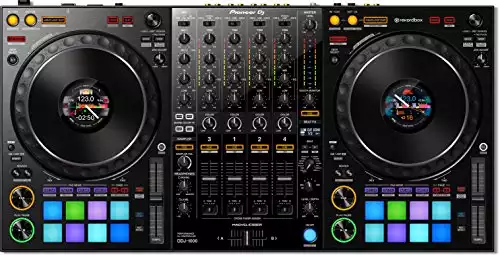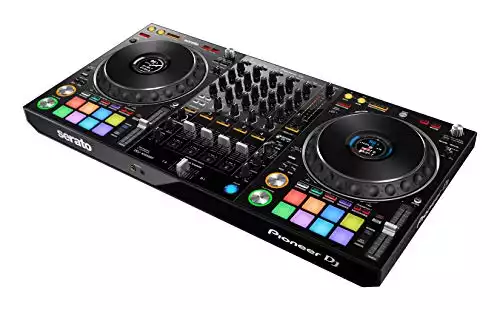What are the differences between these two DDJ 1000 machines?
When the DDJ-1000 first came onto the scene, it was an instant smash hit. Between the controller’s look, its feel, and all the things it could do, it was on just about everyone’s watch list.
Well, almost everyone’s ‘watch list’.
Because the DDJ-1000 was exclusive to the Rekordbox software, that meant that fans and followers of the more popular Serato DJ software were forced to either completely uproot their software of choice or lose out on an all-around stellar controller.
DDJ 1000 Vs DDJ 1000SRT: Overview
The good news is that Pioneer DJ eventually heard the unrest brewing and decided to partner up with Serato DJ to create the DDJ-1000SRT.
The bad news is that it wasn’t a 1-to-1 copy. Despite its initial creation to simply appease non-Rekordbox users, the DDJ-1000SRT has a few new things that help it stand out as something unique and wholly on its own.
While it’s unlikely that people who are deeply entrenched in one camp or the other (rekordbox vs. Serato DJ) will see enough of the other to jump ship, there’s more than enough difference between the two to sway a neutral third party to pick one over the other.
In this comparison guide between the two controllers, we’ll check out what they’re about as well as how they stack up against each other in terms of their relative strengths and weaknesses.
Lastly, we’ll give each a verdict before giving a final verdict so that you can see which of these two is right for the type of DJ performance you want to give.
Pioneer DJ DDJ-1000 Explained
Considered the OG between the two, the DDJ-1000 was very much meant to be Pioneer DJ’s passion project. Meant to transform the DJ space, the DDJ-1000 was starkly different from previous controller types of its time, having a setup that was more in line with club performers while still retaining things like the performance pads.
Without question, it was (and likely still is) the biggest selling point for someone to check out their Rekordbox software.
The controller weighs around 13.2lbs and has an end-to-end width of 27.8 inches, a height of 2.88 inches, and a depth of 14.2 inches.
The controller has 4 channels along with a pair of 8-inch jogwheels. The DDJ-1000 has 18 different FX options, 8 performance modes, and 6 key controller features.
In terms of its main features, the DDJ-1000 includes an on-display screen for its jogwheels that is color customizable.
Its club-style layout comes with an improved MAGVEL crossfader as well as 4 new FX options, including Enigma Jet, Mobius Saw & Triangle, as well as Low Cut Echo.

Read this next: DDJ 1000: The Best Pioneer DJ Controller Ever?
What We Like:
- Impressive Build Quality & Layout
- LCD On-Display Jogwheel Screens
- Responsive Performance Pads
- Native To Rekordbox Software
Impressive Build Quality & Layout
As mentioned earlier, the first thing you’ll probably notice is how the DDJ-1000 is built. This is not only true of its layout but its general structure as well.
The controller benefits from the Pioneer DJ name with high-quality aluminum and an acrylic top panel. This causes it to feel amazing while also being surprisingly lightweight and manageable considering its size.
From a layout perspective, the controller works to fulfill a more club-DJ setup. Here, you’ll notice its knobs, buttons, and overall features are more in line with CDJs or DJM equipment rather than the earlier controller layouts.
A great example of how the layout has helped bring more people in is its improved MAGVEL FADER. This is great for scratch DJs that had previously felt left out of a good controller and had to largely make do.
The fader comes alongside the controller software to ultimately reduce latency, making scratching that much more intuitive.
LCD On-Display Jogwheel Screens
In addition to the overall layout of the controller, the DDJ-1000 comes with two color customizable LCD jogwheels. These 8-inch jogwheels each have their respective display on top of them, presenting everything you’d need.
This includes a track’s BPM as well as the playback position, waveform, as well as Hot Cue points and Loop points.
What makes these jogwheels particularly interesting is the fact that their color can be customized. While this won’t be anything particularly crazy or outrageous, it is a fun little inclusion that makes you stand out all that extra bit more.
Responsive Performance Pads
The DDJ-1000 also comes with a super responsive and extensive performance pad. It contains over 16 different performance features on its rubber-backed pads. These pads feel incredibly comfortable to press on while also being very responsive.
Just a few of the examples of different features include Beat Jump, Hot Cues, or Pad FX, with many, many more.
Native To Rekordbox Software
The last big thing with the original DDJ-1000 is the inherent reason we have two controllers in the first place: the software. Here, the DDJ-1000 comes with Pioneer DJ’s very own rekordbox DJ software pre-set and native to the controller. This is a big deal for two major reasons.
The first reason is that rekordbox DJ software is easily on par with its main competitor, Serato DJ Pro. While it doesn’t have all of the same available features as Serato, rekordbox is fast becoming the favorite among starting DJs, often with many citing the DDJ-1000 as the cause.
The software comes with considerably more in its free option compared to Serato while also having a cleaner and easier-to-use setup that even some Serato fans can’t help but admit is pretty solid.
The other big point for the DDJ-1000’s software choice is the fact that rekordbox, like the controller itself, is a Pioneer DJ device.
This means that everything runs naturally and how it was initially intended. Not only that but this further results in a more affordable experience, with more features being unlocked for free with Rekordbox since the company isn’t required to pay any outside fees the same way the 1000SRT does.
In addition to Rekordbox, the DDJ-1000 is also capable of working alongside the VirtualDJ software though at a lesser rate.
What We Don’t Like:
- Doesn’t Use Serato
Doesn’t Use Serato
This may seem like a bit of a strange criticism to levy against the original controller, but the reality is that, had it come with an initial Serato software add-on, there wouldn’t be a need for an alternative controller altogether.
It honestly comes across as a way to double-dip on selling the product and forcing a semi-artificial controller war where there didn’t need to be one.
While Rekordbox is a fully integrated Pioneer DJ software, it’s not going to have all the different fun additions offered to Serato fans, even if they’re behind a paywall to access.
Read this next: What Is Rekordbox DJ? The Big Beast DJ Software
Verdict
When it comes to the DDJ-1000, the reality is that it’s always going to have a leg-up over the competition, even if that competition is itself.
In this case, in particular, the controller has everything you would ever need in a stellar device while also being put together in its original and intended form.
All in all, while I can’t say that anyone that is a Serato fan should jump over to the original’s spot, the truth is that everything was built with rekordbox in mind.
As such, I would strongly urge anyone interested to choose the DDJ-1000 before any of the other DDJ devices, potentially including its SRT alternative.
Pioneer DJ DDJ-1000SRT Explained
Now that we’ve had a chance to look at the original controller’s strengths and weaknesses, let’s see if there are any significant differences or points to bring up here.
So, the main selling point here is that, if the person is interested, they can get the same DDJ-1000 that previously was unavailable to them due to the lack of a Serato-based version.
The truth is that there is very little difference between the original version and the Serato alternative. From the controller’s overall size and weight to the number of channels available, to even the inclusion of things like the MAGVEL FADER.
What it does differently is largely based on its performing software and some of the dedicated FX features. Just as well, the controller makes a point to emphasize its 4 input options despite having the same feature as the original.

Read this next: Pioneer DDJ-1000SRT: Best Serato Controller Ever?
What We Like:
- Serato DJ Software
- Professional FX Features
- Maximizes 4-Input Use
Serato DJ Software
The first selling point for the DDJ-1000SRT is the fact that it uses the Serato DJ Pro software. This software is arguably more extensive even when compared to the native Rekordbox and has several options and inclusions that aren’t included in Pioneer DJ’s native established option.
An example of this is Serato Studio, which is a DJ-focused piece of production software only available with Serato DJ Pro.
Professional FX Features
The second area where the DDJ-1000SRT differs from the original is in its focus on FX options. While the DDJ-1000 comes with several FX options, the SRT version offers to enhance them through the prioritizing of their use.
While coming with many of the same Beat FX options, the SRT version focuses more heavily on 4 super popular Sound Color FX options, including Filter, Dub Echo, Pitch, and Noise.
Maximizes 4-Input Use
Last on the list of included features is the fact that it makes a point of emphasizing its 4 available input channels. While these 4 inputs are equally available on the original, the SRT version makes them slightly more of a point of focus.
These input options allow a DJ to connect to a variety of other DJ-based items or equipment such as a CDJ, analog turntable, or an additional DJ mixer.
These input options can be connected directly to the microphone or PA speakers using either the Master, Mic, or Booth input options.
What We Don’t Like:
- Increased Price
- Largely The Same
- Doesn’t Include Rekordbox (At All)
Increased Price
A downside to the alternative option here is that, while virtually everything is the same, one of the points that are different is the price tag.
Not only is Serato DJ Pro a more expensive option compared to Rekordbox, but the DDJ-1000SRT is also generally going to be a bit more expensive as a controller when pitted against the slightly older and more native option.
The price isn’t going to be particularly prohibitive, no.
But it will be noticeable, meaning that it’s just a factor you’ll have to deal with.
Largely The Same
The second drawback to the SRT alternative is the simple fact that they strove a bit too close to the same when all was said and done.
Rather than make a point of adding more exclusive features for the DDJ-1000SRT to intentionally set it apart, they pretty much just made the only difference in its software.
In my opinion, this somewhat trivializes the SRT, as it comes across more like an altered DDJ-1000 than something expressly its own thing. And when you factor in that it will likely cost more, it becomes a bit difficult to swear by.
Doesn’t Include rekordbox (At All)
Lastly, this has the same setback as the original DDJ-1000 only in reverse. Just as the original lose out for not including Serato, this one similarly is weakened by not including any type of rekordbox software.
The reason why I see this as a problem is that it forces the DJ into a box where he has to pick one or the other rather than choosing to pick one or the other.
If instead, both included a smaller and less capable alternative, rekordbox users could still opt for the SRT if it offered other things that made it more compelling. Instead, even if they may like the newer SRT, its lack of rekordbox support means it’s entirely useless as a controller for them.
Read this next: What Is Serato DJ?
Verdict
Overall, while there are many things about the DDJ-1000SRT that are great, the unfortunate reality is that the vast majority of them are found with the original DDJ-1000.
This means you’re choosing to pay more despite almost everything being the same between the original and the SRT.
If you’re a Serato fan, I suppose you only have the SRT as an option, however, anyone interested in rekordbox or Virtual DJ will have all of the same benefits with the original controller.
Which Is Best?
This is kind of a trick question when you think about the fact that, technically speaking, they are the same controller.
The thing that makes them the most different is the fact that the original DDJ-1000 is natively meant to use Rekordbox and Virtual DJ software whereas the DDJ-1000SRT has been made to use Serato DJ Pro.
Overall, while Serato is pretty great software, in this instance, it’s only worth the investment if you’re a staunch fan. If you are a fan of Rekordbox, Virtual DJ, or are just on the fence, there isn’t any real reason to justify getting the DDJ-1000SRT.
Not only is it not native to the device (meaning there will be some slight issues regardless) but it’s generally going to cost more for virtually the same product.
Again, if you’re already using Serato DJ software, this is all you have. Outside of that, everyone else should just stick with the OG.
DDJ 1000 Vs DDJ 1000SRT: The Verdict
While I get what Pioneer was trying to do by attempting to appease both their audience and the Serato crowd.
At the time that it was released, the vast majority of people were Serato-only, largely because that was (and still is, to be fair) the software of choice.
Today, however, that isn’t quite the same.
With rekordbox growing leaps and bounds over the years, it seems a bit silly to use a controller that is ill-formatted to its software when you don’t have to. Either use both software options or just get the original controller.
The SRT doesn’t make too much sense today.






